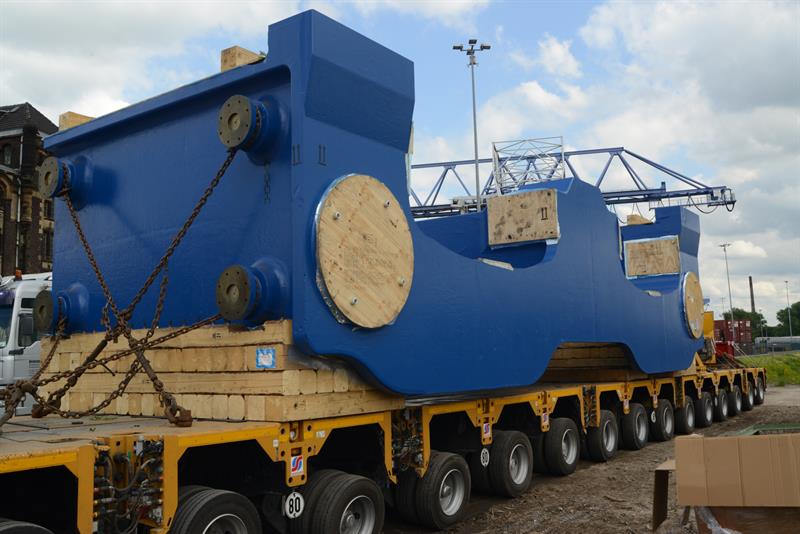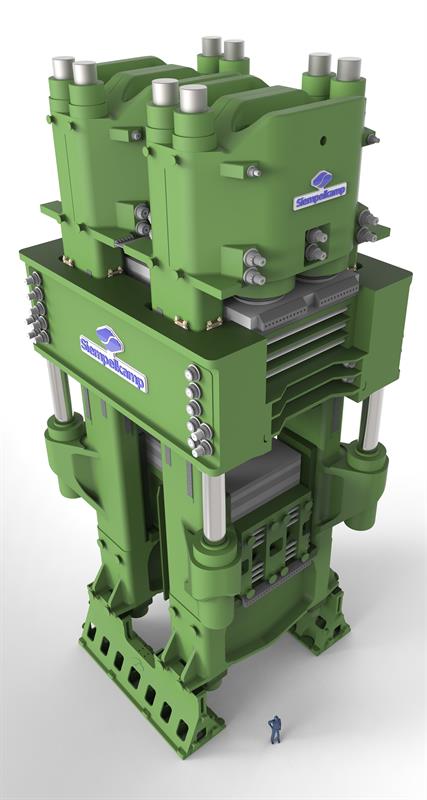The intended application is the shaping of structural components from titanium, titanium-aluminium or Inconel at 500 meganewton and a tolerance of 0.05 mm. The customer is a subsidiary of China's Nanshan group: Nanshan Aluminium, which is among the leading users of aluminium and titanium alloys for the production of structural components for use in the aerospace industry. In fact, Nanshan already uses the previous largest drop-forging press built in Germany for the production of near-net forged components for the Airbus 380 long-haul airliner. In addition to turbine disks, these also include so-called ‘inner wings’, which connect the wings to the fuselage, and must therefore assure not only high-precision forming but also ultra-high strength.
For the latest press, a total of 26 large components were successively cast using ductile cast iron at Siempelkamp's Krefeld foundry. The two lower beams, at 287 tonnes finished weight each, were the heaviest units. Casting them using 320 tonnes of molten iron delivered in five ladles brought Siempelkamp a new world record on that score.
Almost ‘routine’ for the foundry, on the other hand, were the middleweight components for the Nanshan press, such as the two foundation stools, each of 80 tonnes finished weight. Set against this, the four locking supports, each of 'only' eight tonnes finished weight, could almost be regarded as ‘flyweights’. Large castings, such as those for the press for Nanshan, need around four weeks to cool in the sand pit after casting, incidentally.
For the subsequent large-scale machining operation, the components were taken to the machine shop only 400 m away on the same site on a heavy-duty multi-axle trailer. The machine shop has cranes that can lift 480 tonnes and extensive range of large-format CNC machines, including a gantry-type machining centre.

Transport to the machine shop for these large castings
A total of 12 pressure distribution plates were used, each with as-cast weights of 39 tonnes and more, with the production of the plates of 510 mm thickness representing a ‘first’, even for the world's leader in the heavy plate sector.
Nanshan set demanding specifications: a 280 tonne component may not exceed a tolerance of 10 mm, even under exposure to heat. The 2,500 reciprocating tonnes of the moving beam are driven by eight hydraulic cylinders, each of them exerting a press force of 6,250 tonnes. Four retraction cylinders, which are designed to achieve precisely the specified eccentricity and lift for the moving beam, are necessary to apply the 50,000 tonnes as uniformly as possible to the customer's forming die of 1,000 mm diameter. Equally critical is the positioning accuracy of the drive table and moving beam in lowering the 2,500 tonne load at the defined rate of 190 mm per second.
The 500 meganewton Nanshan press forms one large structural component per press cycle. It features an additional internal and external line injector for the production of smaller components, such as turbine disks.
Pressure distribution plates, calculated using the finite element method, ensure that the specified tolerances of between 0.5 and 1 mm are met. “With an 11 m long moving beam and a tolerance of 1 mm per m, the moving beam may flex only by a maximum of 11 mm when 50,000 tonnes of press force is applied,” notes Christoph Schmitz, head of the mechanical design group at Siempelkamp, illustrating the challenges involved.
All the pressure distribution plates and the line injector were fabricated from Grade S355JR+N heavy steel plate supplied by Dillinger.
The calculation, design, production, inspection and packing of all 8.000 tonnes of components for the 500 meganewton drop-forging press consumed a total of 40,000 man hours of work for Siempelkamp, which was also responsible for shipment to China, installation and commissioning.





